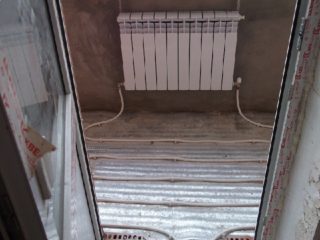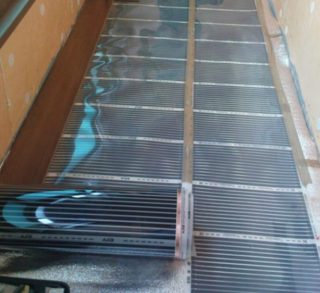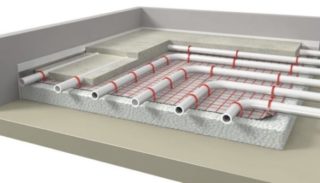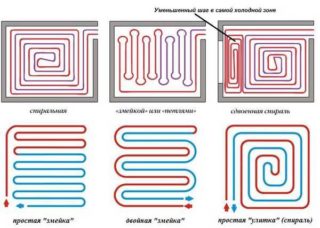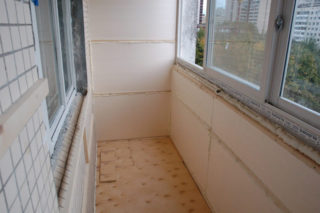It is rational to equip a warm floor on the balcony only with an understanding of all the features of installation. In some cases, it is undesirable to use this method of heating without the main one, since it will be too costly.
Is it possible to warm the balcony with warm floor
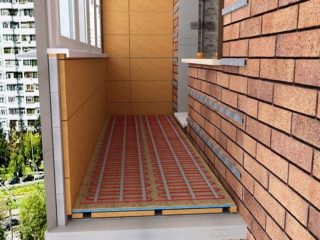
to maintain a constant temperature
A balcony or loggia, where the microclimate is optimal for living conditions, can play the role of additional space. Usually there is a small dining or guest area. It is possible to heat this room with one underfloor heating. But for this you need to pre-insulate the balcony structure. To organize this correctly, you need to take into account some features:
- constant temperature on the loggia should be in the range of 22-25 degrees;
- it is better to install plastic double-glazed windows as windows;
- periodic heating of the floor will be rational if there are indoor plants in the room;
- during installation, for proper heating, it is necessary to provide a valve (floor heating controller).
If the walls of the balcony are too thin, even the thickest insulation is not able to keep the generated energy from heating. To do this, you need to install an additional stationary battery section.
Advantages and disadvantages of underfloor heating
When installing a warm floor, all the air in a small room warms up evenly. Therefore, even under the ceiling a comfortable temperature will be kept. Such conditions are suitable for a pleasant leisure time and indoor gardening. The main advantages include:
- durability of a design;
- radiates enough energy;
- does not require the involvement of specialists for installation;
- works from the centralized or electric heating device;
- not demanding to care, hiding under the floor;
- mounted under a thick layer of concrete (this makes it possible to level the floor).
In a small room, in order to avoid heat and dryness, it is necessary to install pipes of the warm floor at a distance of 15-20 cm from each other.
The disadvantages of this heating system include:
- administrative fines if water heaters are equipped;
- the mass of the floor during installation increases by 10-15%, which is unsafe for high-rise buildings;
- installation takes a lot of time and requires careful preparation of the surface.
You can circumvent the sanctions and legally equip the floor in the loggia if its area does not exceed 2.2-2.5 sq.m.
Which option to choose
Floor heating on the balcony can be carried out in various ways: water, electric, film. Each of them has its own characteristics, which must be remembered when choosing.
Water floor heating
Such equipment is characterized by a complex installation process. A lot of additional materials are used for it: reflector, vessels, plugs, clamps. This option is suitable for apartments where central heating is organized. It can be connected to a stationary boiler or work autonomously. Such a design is in most cases unacceptable for equipment in high-rise buildings due to the heavy weight.
Electric
Electric heating is quite complicated and expensive.For its installation, it is necessary to equip special channels and stock up on fasteners. It is mounted similarly to a water one - a snake. Be sure to include a temperature controller in the kit. It controls the temperature and makes it possible to correct it. Such a system does not overheat and does not collect air. For this heater, a separate outlet is installed with a power of 220-380 Volts, depending on the type of wiring in the house.
Film or infrared
The heating element is a thin film equipped with graphite rods that carry out the heating function. These conductors take on the current coming from electricity. Floor heating is uniform and efficient. This design is more suitable for arrangement in small rooms. To heat a sufficient floor area will require large energy costs.
What are the requirements for a balcony?
The rough surface of the balcony floor must meet certain requirements. They must be provided before installing the heating structure. The following conditions must be met:
- perfectly even preliminary coating - is checked by the level in different positions relative to the walls;
- if the concrete screed was poured, it must dry completely, otherwise the whole structure may be deformed;
- the hydrobarrier and the reflector are necessarily placed under the “snake” of heating.
The listed requirements are presented to any type of heating equipment.
Installation of underfloor heating on the balcony
For this design, several stages of work are provided. It is important to observe them so that the warm floor is distinguished by effective work.
Surface preparation
If the balcony has not been repaired and only the concrete slab acts as the floor, it is necessary to prepare it for creating an additional screed. To do this, beacons are installed and cement mortar is poured. Such work makes it possible to even out the slope.
Laying material and heating system
After the concrete screed is completely dry, you can proceed with the installation of the warm floor.
- A reflective sheet is laid, it does not need additional fastening.
- On top of the reflector, small clamps must be fixed on the screws every 10 cm in several rows.
- The fasteners are installed underfloor heating pipes. Both ends are led to the junction with the heating equipment.
- The structures are soldered together, water is first drained from the heating system.
- All batteries and pipes are bleed (air plugs are removed).
- The main screed is poured for laying tile or laminate, after drying, the lining is made.
All concrete coatings should be moderately thick. If you just need to level the floor for finishing, it is desirable that the solution layer does not exceed 1-2 cm.
When installing an infrared floor under a laminate with low thermal conductivity, the concrete screed is not poured. Cladding is performed directly on the substrate on top of the energy emitter. It is necessary to calculate the installation location of the outlet, as well as the sufficient length of the electric cable.
What errors can be encountered
Many beginning masters believe that it is impossible to completely heat even a small room with a warm floor. Such a result is possible in case of improperly performed preliminary work and insulation. It is important to know about common mistakes that are easier to prevent than to eliminate later.
- The installed radiator on the balcony does not match the size of the window. It should have a width similar to the length of the windowsill.
- There is no calculation of energy loss. It must be done before the moment when the “snake” of the warm floor is laid.
- Improper pipe pitch can also affect the functionality of installed equipment.It should not exceed 20 cm.
- Poor isolation or lack thereof. If there is no reflector before laying the tubular floor, as a rule, all the heat will go down.
- Lack of compensation clearances. Under the influence of heating, the screed begins to expand and the finish coating burst.
- Incorrect circulation pump causes increased energy consumption. The energy carrier must circulate evenly throughout the system.
If the balcony is equipped with underfloor heating, do not lay carpets or walkways on top. They take all the heat energy on themselves. As a result, the room will be cold.
Insulation of the walls of the balcony before laying the warm floor
For the correct operation of the structure, it is important to choose the optimal insulation. It is better to give preference to options with a rigid structure. In most cases, polystyrene foam is used for this purpose. It is fixed with PVA glue, as well as using special mounting fungi.
The use of underfloor heating for apartment balconies is acceptable provided that the infrared or electric option is selected. The water type of the heater is allowed only in private houses with a foundation, since the construction of the warm floor is multilayer and quite heavy.

